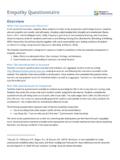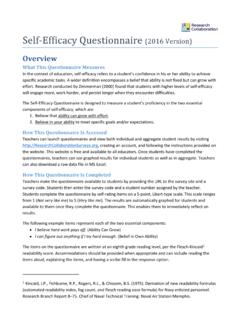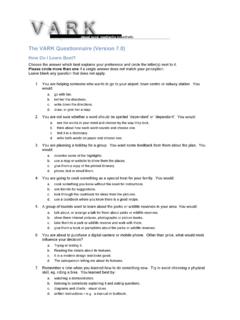Transcription of A STUDY ON TEACHER CHARACTERISTICS AND THEIR …
1 103 The Reading Matrix Vol. 5, No. 2, September 2005 A STUDY ON TEACHER CHARACTERISTICS AND THEIR EFFECTS ON STUDENTS ATTITUDES F rat A kg z Abstract _____ Adequately defining the students perceptions about teachers has been at the core of much research and controversy for many years. The present STUDY administered a questionnaire in the Turkish mono-lingual setting and was done as an extension of earlier studies to provide feedback to Turkish teachers. A total of 181 9, 10, 11 grade students attending four different state schools answered a questionnaire and three open-ended questions aimed at assessing THEIR attitude toward THEIR perceptions of TEACHER CHARACTERISTICS (professional, pedagogical, and personal), as well as learning. The results might illuminate the ways of reaching at a better learning atmosphere through self-assured and self-esteemed students. _____ Introduction Classroom management is frequently conceptualized as a matter of control rather than as a dimension of curriculum, instruction, and overall classroom climate (Duke, 1982).
2 As our greatest concern has been to try to avoid prescriptive behavior in its general sense within classrooms, there is, in fact, a certain degree of tension and misattribution between flexibility of control and prescriptive attitudes in the classroom atmosphere. Therefore, we have to persuade ourselves that not everyone will express things in the same words or perceive them in the same way, and that not everyone will move at the same rate or in the same direction. Based on the findings of the research conducted by Borophy (1988a:1), it is highly probable that teachers who approach classroom management, as a process of establishing and maintaining effective learning environments, and as a multi-lateral ambience, tend to be more successful than others who place more emphasis on THEIR roles as authority figures or disciplinarians since classrooms are composed of numerously different personal views, CHARACTERISTICS , ethics and values.
3 In order to find a solid foundation for relationships, Buddhist psychology proposes that we (in our case: teachers and students) need to consider what we most value in our connection with someone we care about (Beck, 1993). What are the moments in a relationship we most cherish in real life? Considering that the classroom setting is some sort of a compact and miniaturized version of what we encounter in real lives of ours. It is fair to say that students primarily need to be recognized in such a classroom setting too. Otherwise, renewal and improvement would not come into being, especially when students are aware of the particular ways of "wearing a mask" so as to avoid being hurt again (Craig, 1994). 104 The classroom climate influenced by the TEACHER has a major impact on pupils motivation and attitude towards learning, that is to say, for teachers, having been equipped with pedagogical and professional CHARACTERISTICS would not be enough to establish a positive, learnable, and teachable classroom climate.
4 Specifically, the factors that best facilitate student learning are considered to be the ones that are described as being purposeful, task-oriented, relaxed, warm, supportive, and has a sense of order and humor in an integrated sense (Kumaravadivelu, 1992). He also speaks positively of other factors facilitating students learning in a positive manner such as; mutual respect and rapport etc. all of which stem from conveying to pupils that you understand, share, and value THEIR feelings as individuals on a whole range of matters and experiences, academic, social and personal. Such a climate fosters learning and motivation of students and THEIR attitudes toward learning process. Furthermore, Research indicates that certain personality CHARACTERISTICS influence student evaluations of teachers. From the students' points of view, TEACHER -expressive CHARACTERISTICS such as warmth, enthusiasm, and extroversion apparently separate effective from ineffective teachers (Basow, 2000; Basow & Silberg, 1987; Best & Addison, 2000; Bousfield, 1940; Cravens, 1996; Feldman, 1986; Guerrero & Miller, 1998; Marsh & Roche, 1997; Radmacher & Martin, 2001) Reasoning in this way, out of three generally accepted CHARACTERISTICS of teachers, namely; professional, pedagogical, and personal, the last one of the three will illuminate, as a neglected vision to follow the end product-shapeable students, the ways of reaching at a better learning atmosphere as well as self-assured students.
5 A combination of my experiences and some other colleagues directed me to STUDY what the TEACHER was like as an individual and how influential it is over students attitudes towards learning and the degree of THEIR engagement with learning. The proposition in mind was that pupils' attitude towards learning and being in a classroom was not just related to the technical or pedagogical competence or the professional qualities of the TEACHER , but it was related, in part, to what the TEACHER was like as a person. It is, in this paper, referred to as having a sort of rational human being' qualities. The present STUDY was designed to investigate students' self-reported beliefs with a Data collection package (henceforth DCP) designed to assess students attitudes towards teachers and learning. The STUDY examined a questionnaire and three open-ended questions included in the DCP concerning TEACHER CHARACTERISTICS , students beliefs about teachers attitudes, THEIR self-reported practices, and the relations between THEIR self-reported beliefs about teachers attitudes.
6 METHOD Participants The participants were 181 (140 females; 40 males) high school pupils enrolled in 4 different state schools in two provinces of Turkey. The views of 181 pupils, 9, 10, and 11 graders of high schools have been surveyed through the DCP. THEIR ages ranged from 16 to 18 years old. Six schools were asked to participate in the STUDY . Letters taken from the Directorate of National Education and phone calls were used to encourage school participation. Four schools out of six participated in the small scaled cross-school project. Instruments 105 The TEACHER questionnaire (henceforth TQ) was developed out of an existing literacy survey (Zamorski, 2002; Haydn, 2002) in accordance with the needs of Turkish students. TQ was translated into Turkish. The items on the TQ and other questions were intended to sample students' beliefs and THEIR self-reported practices towards THEIR attitude to Teachers, learning and being in a classroom as direct participants.
7 In addition to assessing students' beliefs, the TQ and other questions needed to have information about school, age of pupils, gender and THEIR ability level in classes, which was achieved through collecting pre-data about students before implementing the data collection package. ( , student grades, student participation during class-time). Prior to distribution of the data collection package, five high school teachers reviewed the instruments and offered suggestions about content and format. The survey was revised accordingly. The DCP contains two sections: (a) TQ (b) Open-ended questions: what are the things that most put you off being in the classroom/learning a subject?-What are the things which most make you feel OK about being in the classroom/learning a subject? - Is there any other comment you would like to make about teachers, lessons, and how you are taught at school in general?
8 Procedures The Directorate of National Education provided a contact list for English Division classes of state schools. All participating students received a letter requesting THEIR cooperation prior to the administration. Because the TQ included students evaluation of THEIR teachers, the confidentiality of the responses was ensured. Data collection packages were distributed to the teachers in 4 high schools and the administration process began in the morning with a preliminary speech addressed to the participants and continued till the lunch break, 22nd of May, 2004. A list of ' TEACHER CHARACTERISTICS ' was adapted and arranged, which was a mixture of: technical/pedagogical capability, ( "Explains things well", "Controls the class well"), professional qualities ( "Marks and returns your work promptly", "Always seems well prepared"), and personal CHARACTERISTICS , which might also be defined as a TEACHER 's 'style' of teaching ( "Is friendly", "Says hello or nods to you outside the lesson").
9 The pupils were asked to circle the items on TQ. Students indicated the extent to which they agreed or disagreed with the statement using a 4-point Likert-type scale. The scale was anchored at one end by unimportant and at the other end by essential, meaning that a high score indicated strong endorsement of the item. The guidance given to pupils during the questionnaire can be seen in the Appendix I. Data Analysis In order to fulfill the stated goals of this STUDY , the items were analyzed by using factor analytic methods. The internal consistency reliability of the scale, assessed by Cronbach , was found to be Given that Cronbach is dependent upon the number of a scale it contains, this reliability coefficient is highly acceptable (Backhouse, Dickins, Rayner&Wood, 1982). At first hand, the responses given by the students to TQ were factor analyzed and gathered under 3 subgroups (dimensions).
10 Since factor analyzing the input displayed that the items available in TQ were to be put into three subgroups namely, pedagogical, personal, and professional, the specifically obtained factors (dimensions) were named as the results displayed. The distributions of the scorings that students marked 106were taken into consideration as descriptive findings. Additionally, variance analysis was used to test the gender and grade differences of students scorings. At the final stage, subgroups obtained from factor analysis procedure were tested with Multi-Dimensional Scaling method of SPSS. Apart from TQ, open-ended questions that revealed students views were included in the analysis as a case STUDY . Results The following are the statistically analyzed results of the TQ under the necessary headings: Results of the pupil responses As can be seen in Table 1, the mean scores of pedagogical and personal factors obtained from 181 participating students seemed to be nearly the same, whereas the professional mean scores were significantly lower than the other two factors.
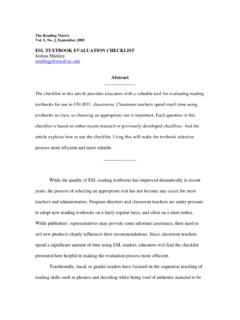
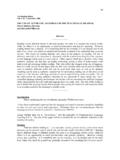
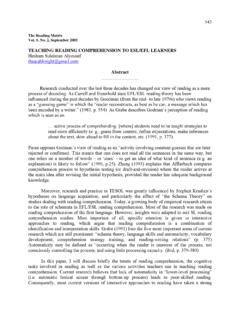
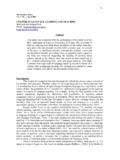
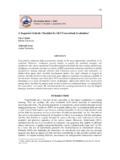
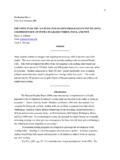
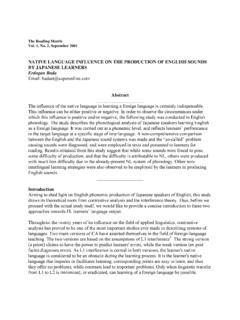
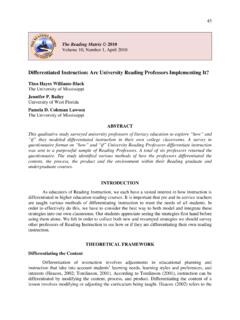
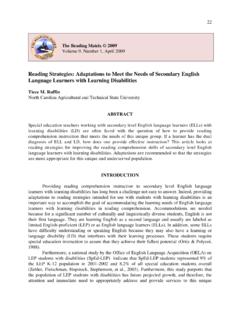
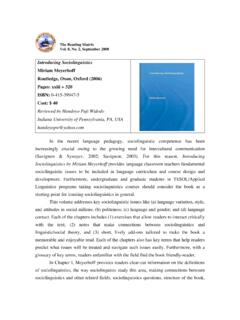
![Teacher Questionnaire [<ISCED level x> or PISA schools]](/cache/preview/2/1/b/2/b/b/6/4/thumb-21b2bb646982cb9c8802c5e671074293.jpg)
